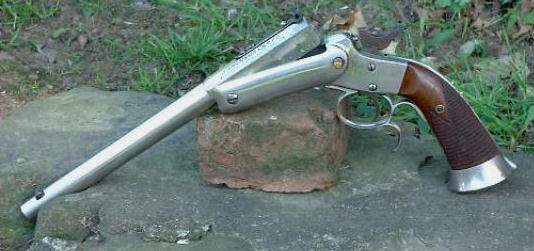

 The Accurate Reloading Forums
The Accurate Reloading Forums  THE ACCURATE RELOADING.COM FORUMS
THE ACCURATE RELOADING.COM FORUMS  Guns, Politics, Gunsmithing & Reloading
Guns, Politics, Gunsmithing & Reloading  Single Shot Pistols
Single Shot Pistols  Velocity Gain and the 1/4 Rule
Velocity Gain and the 1/4 RuleGo  | New  | Find  | Notify  | Tools  | Reply  |  |
| One of Us |
With the present trend in ever larger capacity cases, how much good does adding all that extra powder really do? Not as much as you might think. John Barsness is the gun writer who developed the 1/4 Rule. He didn't name it that but I will let him tell you about it and how it applies. By Mule Deer relating to a 7 x 57 vs a 280 discussion. I was the person who crunched the numbers and came up with the formula (approximate) that any increase or decrease in powder capacity results in 1/4 that increase in potential muzzle velocity, at the same pressure in the same bore size. It is gratifying to see it quoted so much. Once I even saw it quoted as "the old 1/4 rule." I first published it in RIFLE or HANDLOADER (can't remember which) at most 10 years ago, which I guess qualifies as "old" in this era of the Internet. I worked out the formula partly because of discussions like this. I had also grown weary of gun writers guessing how much "Ackley Improving" a round would increase the velocity. The formula was developed by crunching the numbers from a bunch of handloading manuals. If you want to argue about it, feel free. But first spend a few days crunching numbers so we have something realistic to argue about. The .280 has about 20% more powder capacity than the 7x57, with the same bullet seated to factory overall length (about 3.1" in the 7x57 and 3.35" in the .280). Exactly how much depends on brass weight, but 20% is pretty close. Thus the .280 can drive bullets about 5% faster when loaded to the same pressure, in the same barrel length. If the 7x57 is capable of 2700 fps with a 160-grain bullet, then the .280 will drive the same 160 to 2835. If the 7x57 is capable of 2900 with a 140, then the .280 can drive the same bullet to 3045, again everything else being equal. I see that somebody has brought up the old myth about needing a longer barrel in the .280, to burn up all that slow powder. This is indeed an old one, but the truth is that just about all the smokeless powder that's going to burn in a rifle round (99%+) burns by the time the bullet has traveled maybe 2 inches in front of the chamber, exactly how far depending on various factors. The bullet continues to accelerate because the gas produced by the powder continues to expand, not because the powder is still burning. In reality, the powder that produces the most velocity in a 26" barrel also produces the highest velocity in an 18" barrel. This has been proven over and over again. In fact, the LEAST loss of any load's velocity in shorter barrels generally comes from a combination of slow-burning powder and heavy bullets. Rusty again, I would like to add this also holds true for pistol length barrels. | ||
|
| Powered by Social Strata |
| Please Wait. Your request is being processed... |
|

Visit our on-line store for AR Memorabilia

